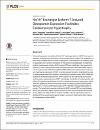In vitro evaluation of Neosetophomone B inducing apoptosis in cutaneous T cell lymphoma by targeting the FOXM1 signaling pathway
| Author | Kuttikrishnan, Shilpa |
| Author | Masoodi, Tariq |
| Author | Ahmad, Fareed |
| Author | Sher, Gulab |
| Author | Prabhu, Kirti S. |
| Author | Mateo, Jericha M. |
| Author | Buddenkotte, Joerg |
| Author | El-Elimat, Tamam |
| Author | Oberlies, Nicholas H. |
| Author | Pearce, Cedric J. |
| Author | Bhat, Ajaz A. |
| Author | Alali, Feras Q. |
| Author | Steinhoff, Martin |
| Author | Uddin, Shahab |
| Available date | 2024-03-13T05:14:57Z |
| Publication Date | 2023 |
| Publication Name | Journal of Dermatological Science |
| Resource | Scopus |
| ISSN | 9231811 |
| Abstract | Background: Cutaneous T cell lymphoma (CTCL) is a T cell-derived non-Hodgkin lymphoma primarily affecting the skin, with treatment posing a significant challenge and low survival rates. Objective: In this study, we investigated the anti-cancer potential of Neosetophomone B (NSP-B), a fungal-derived secondary metabolite, on CTCL cell lines H9 and HH. Methods: Cell viability was measured using Cell counting Kit-8 (CCK8) assays. Apoptosis was measured by annexin V/PI dual staining. Immunoblotting was performed to examine the expression of proteins. Applied Biosystems' high-resolution Human Transcriptome Array 2.0 was used to examine gene expression. Results: NSP-B induced apoptosis in CTCL cells by activating mitochondrial signaling pathways and caspases. We observed downregulated expression of BUB1B, Aurora Kinases A and B, cyclin-dependent kinases (CDKs) 4 and 6, and polo-like kinase 1 (PLK1) in NSP-B treated cells, which was further corroborated by Western blot analysis. Notably, higher expression levels of these genes showed reduced overall and progression-free survival in the CTCL patient cohort. FOXM1 and BUB1B expression exhibited a dose-dependent reduction in NSP-B-treated CTCL cells.FOXM1 silencing decreased cell viability and increased apoptosis via BUB1B downregulation. Moreover, NSP-B suppressed FOXM1-regulated genes, such as Aurora Kinases A and B, CDKs 4 and 6, and PLK1. The combined treatment of Bortezomib and NSP-B showed greater efficacy in reducing CTCL cell viability and promoting apoptosis compared to either treatment alone. Conclusion: Our findings suggest that targeting the FOXM1 pathway may provide a promising therapeutic strategy for CTCL management, with NSP-B offering significant potential as a novel treatment option. |
| Sponsor | This work was supported by the grants funded by the Medical Research center (MRC), Hamad Medical Corporation , Doha, Qatar ( MRC-01-21-301 ). |
| Language | en |
| Publisher | Elsevier |
| Subject | bortezomib caspase 3 forkhead box protein M1 natural product neosetophomone B nicotinamide adenine dinucleotide adenosine diphosphate ribosyltransferase S phase kinase associated protein 2 unclassified drug aurora A kinase forkhead box protein M1 FOXM1 protein, human antineoplastic activity apoptosis Article cell viability combination drug therapy controlled study cutaneous T cell lymphoma cytolysis double stranded DNA break down regulation drug efficacy drug potentiation drug targeting enzyme activation gene expression profiling gene silencing H9 cell line IC50 in vitro study mitochondrial membrane potential monotherapy proapoptotic activity signal transduction human metabolism pathology skin tumor tumor cell line Apoptosis Aurora Kinase A Cell Line, Tumor Forkhead Box Protein M1 Humans Lymphoma, T-Cell, Cutaneous Signal Transduction Skin Neoplasms |
| Type | Article |
| Pagination | 83-91 |
| Issue Number | 2 |
| Volume Number | 112 |
Check access options
Files in this item
| Files | Size | Format | View |
|---|---|---|---|
|
There are no files associated with this item. |
|||
This item appears in the following Collection(s)
-
Laboratory Animal Research Center (Research) [127 items ]
-
Medicine Research [1673 items ]
-
Pharmacy Research [1365 items ]




